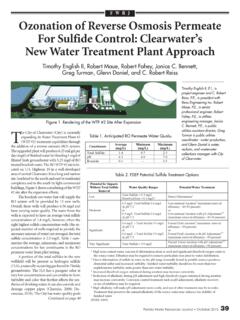Transcription of Amine Treating Plant General Operation - Blue Sky …
1 Amine Treating Plant General Operation Contents Introduction .. 3 Safety .. 4 A. General .. 4 B. hydrogen sulfide Gas .. 4 C. Fire .. 5 Amine Operational Overview .. 6 System Component Operation .. 8 Preparation for Initial Operation .. 21 Amine System Cleaning Procedure .. 23 Amine System Startup .. 24 Plant Pressurization and Start-up .. 24 Charcoal Filter .. 24 Still operations .. 25 Restart of Amine Regeneration Unit .. 26 Amine Unit Operational Suggestions .. 27 Solution Pumps .. 27 Still Operation .. 27 2 Heat Exchanger Performance.
2 27 Amine Contactor .. 28 Solution Loading .. 28 Solution Stripping .. 28 Foaming .. 29 Amine Analysis and Control .. 31 3 Introduction This is provided for General Plant Operation information/guidelines. Safety is of prime importance in any Operation . Amine plants are no exception. Amine Treating plants have natural gas under pressure, rotating equipment, toxic gases, high voltage, All operators must be trained in these areas before working with Amine Treating plants .
3 A safety section is included in this manual, but this does not replace proper training. Always completely assess all situations before progressing. ASSESS BEFORE YOU PROGRESS 4 Safety Assess Before you Progress A. General Operators and other employees having access to the Plant need to be trained in all safety procedures and accept that safety is every ones responsibility, and that it is their duty to report any safety issue or potential safety issues.
4 Operators and others must be aware of the following: 1. Piping systems contain gas or liquid under pressure. Piping systems that need to be opened for maintenance or repairs must be isolated by block valves and depressurized using vents and/or drains provided in the piping or equipment. 2. Pressure Safety Valves (PSVs), also known as relief valves, need to be checked on a regular basis to ensure their proper Operation . 3. Rotating equipment such as fans and pumps are provided with coupling guards. These guards must be kept in place at all times during Operation of the equipment.
5 4. Electrical equipment must be maintained by qualified personnel. Electrical switch gear must be locked out on equipment which is being serviced. B. hydrogen sulfide Gas/ Hazards of hydrogen sulfide hydrogen sulfide is an extremely toxic gas and can cause immediate death. Operating personnel MUST be trained to work in a of hydrogen sulfide environment. Particular emphasis should be given to the problems and situations listed below. Fresh air masks must always be worn when there is a possibility of the presence of toxic concentration of hydrogen sulfide .
6 Typical activities and locations which may permit hydrogen sulfide to escape are: 1. Repair or modifications to equipment or lines containing hydrogen sulfide , such as installing blind flanges, changing orifice plates, acid gas injection equipment and/or PSVs. 2. Sample or purge connections which may be improperly opened. These should have a safeguard such as being plugged or locked when not in use. 3. Water drained from the vent scrubber and reflux accumulator may contain some dissolved hydrogen sulfide which can flash out of solution upon release of pressure. 4. Flare not burning, allowing H2S to settle in low lying areas.
7 (H2S is heavier than air) 5 5. hydrogen sulfide is extremely flammable. Its flammability range is much greater than methane. C. Fire Care should be taken to keep the flanges and other connections tight to avoid leakage of any process gases. Adequate ventilation in all areas to prevent gas No welding should be done in the Plant area except with permission of the supervisor and upon issuance of the proper permits.
8 Flammable gases may be present which may be odorless. Smoking should be restricted to designated areas beyond the perimeter of Plant Operation . 6 Amine Plant Operational Overview The Treating facility for each Plant varies. However each Plant employs an Amine solution for removal of carbon dioxide and of hydrogen sulfide by absorption and chemical reaction.
9 The feed gas is pretreated through a filter coalescer to remove any entrained solids and/or liquids from the feed stream. The gas proceeds through the contactor column where the acid gasses (CO2 and H2S) are removed from the gas stream. The sweetened gas flows through the Sweet Gas Cooler where it is cooled before going to the Overhead Scrubber. The scrubber removes any liquid that is condensed by the exchanger before the sweet gas is processed downstream. The lean Amine is fed into the top of the contactor and flows countercurrent to the gas down through the trays where contact with the gas takes place.
10 The rich Amine is collected in the bottom of the tower. The level is maintained by a level transmitter and control valve which dumps the rich Amine into a flash tank. In the flash tank, hydrocarbon gasses entrained in the Amine are flashed off and directed for disposal. If hydrocarbon liquid is present, it rises to the top of the Amine solution in the flash tank where it can be removed via an internal collection box and then drained to disposal. From the flash tank, the rich Amine goes through a filtration process. A portion of the rich Amine is directed through a carbon filter for the adsorption of hydrocarbons and degraded products from the Amine .






